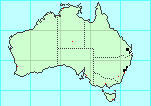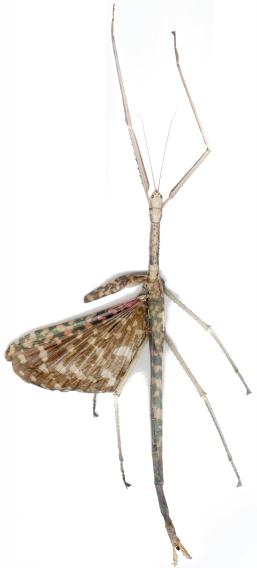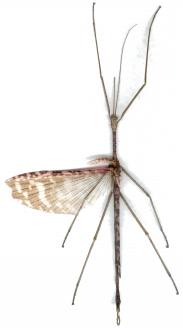Common Name:
Titan Stick Insect
The Great Brown Phasma
Identification:
|
Male |
Female |
| Body Length |
15cm |
22cm |
corpore decem unciarum longo,
subcinereo-fusco lineari, thorace spinulis quibusdam
raris acutis elytris longiore, his nigro-viridibus testaceo
maculatis maculâque in marginis antici medio magnâ
albâ, alis membranaceis nigro-fuscis albo-maculatis,
anticè coriaceis ad basin rubris nigro-maculatis ad apicem
nigro-viridibus testaceo maculatis, pedibus albo-cinereis coxis
anticis trigonis angulo inferiori dentibus magnis rufis postico
minoribus et superiori nullis.
(from Macleay 1826.)
Length: 25cm,
the longest Australian species
Coloring:
Note any distinguishing features.
volant; male and female mesopterous
(from Balderson
et al 1998).
spiny,
Acrophylla titan
of the eastern coast,
with large mottled wings in both sexes
and wavy-margined, three-ridged cerci.
(from Key, 1991)
Female:
The general colour of the wings
is blackish-brown, but irregularly spotted and banded with white; the
costal area is of a greenish-black irregularly spotted with testaceous
and has the base red. The tegmina are similar to the last in colour and
markings, but with a white spot near the centre of each; the head and
prothorax are of a greyish colour; the former has three distinct stemmata
in front; the mesothorax is reddish, but with scattered sharp tubercles;
the abdomen is orange, with the tip and leaflets of a grey colour, the
latter rather short in proportion to those which some species possess,
and are quite differently formed from the others, being trigonal and
dentated; the legs are also short and very much dentated, but the fore
ones are trilateral.
(from Gray, 1833)
Male:
The male is thinner and broadly similar, with full size wings.
The thorax is brownish and the tubercles more numerous and spine-like.
Males are very good fliers.
(from Brock, 1994.)
Nymph:
Nymphs are often green, but sometimes brown; there may be a bold white
longitudinal stripe along the whole length of the body.
(from Brock, 1994.)
Females flick their eggs to the ground which may mean they travel several
feet from the tree below and ensure a better survival rate rather than
if the eggs were simply dropped directly below the insect.
Eggs have a conspicuous "capitulum" or knob on the operculum.
(from Brock, 1994.)
In addition, A. titan may hold the record for
fecundity. Two captive females laid 4104 eggs during their lifetimes with
a total of 178 eggs laid in a single week by the two
(Brock, 1994). In
nature females flick their eggs to the ground away from the base of
the host tree. The capitulum on the surface of the egg
is attractive to ants, which carry the eggs away and bury them.
Habitat:
the eastern coast,
Arborial.
Bribie Island Pine,
Callistemon.
Usually high in the tree.
Similar Species:
Rearing Notes:
Ventilated cages at near room temperature.
Accepts various Eucalyptus species including E. gunnii;
also various Acacia species inclusing A. irorata.
Nymphs appear to require slightly higher humidity than the adults.
PSG notes indicate the following foodplants have been used successfully
in captivity: Eucalyptus, Bramble, Raspberry, Rose.
For a stick insect with body length 220mm, to keep 2 adult females,
you need a cage at least 900mm high, 400mm deep and 550mm wide.
 Range:
Range:
NE coastal NSW, SE coastal QLD.
Status:
It is not known if this species is endangered,
as there is insufficient sighting history.
References
-
Balderson, J., Rentz,
D.C.F. and Roach, A.M.E. (1998).
in
Houston, W.K.K. & Wells, A. (1998) (eds)
Zoological Catalogue of Australia.
Vol. 23.
Archaeognatha, Zygentoma, Blattodea, Isoptera, Mantodea, Dermaptera,
Phasmatodea, Embioptera, Zoraptera.
Melbourne: CSIRO Publishing, Australia (ISBN 0643 06035 9).
pp. 347 - 376.
-
Banks, C.B. (1992).
Notes on egg-laying in an australian stick-insect (Phasmatodea).
Victorian Entomologist, 22(5), October 1992, pp. 116-117.
-
Bedford, G.O. (1978).
Biology and ecology of the Phasmatodea.
Ann. Rev. Entomol. 23: 125-149
-
Brewster, M.N., Brewster, A.A. and Crouch, N. (1946).
Family Phasmidæ (Leaf and Stick Insects).
In
Life Stories of Australian Insects.
Sydney: Lake & Ashes.
2nd Edition.
pp. 26-31
-
Bruins, E. (1999).
The Complete Encyclopedia of Terrarium.
Grange Books.
-
Brock, P.D. (1994).
Giant Stick Insects in Australia:
Notes on Acrophylla titan (Macleay).
Amateur Entomol. Soc. Bull.,
53: 61-67
-
Campbell, K. G., Hadlington, P., 1967.
The biology of the three species of phasmatids which occur in
plague numbers in forests of south eastern Australia.
Forestry Commission NSW Res. Note No. 20, 38 pp.
-
Clark, J.T. (1976).
The eggs of stick insects (Phasmida): a review with
descriptions of the eggs of eleven species.
Syst. Ent. 1: 95-105.
-
Gray, G.R. (1833).
The Entomology of Australia in a Series of Monographs. Part 1.
The monograph of the genus Phasma.
London: Longman & Co. 28 pp. 8 pls
-
Gray, G.R. (1834).
Descriptions of several species of Australian Phasmata.
Transactions of the Royal Entomological Society of London,
i, 1 (November 7), pp. 45-46.
-
Gray, G.R. (1835).
‘Synopsis of the Species of Insects Belonging to
the Family of Phasmidae.’ 48pp.
(Longman, Rees, Orme, Brown, Green and Longman: London.)
- Harman (1999).
Some Notes on rearing Acrophylla titan PSG 154,
Phasmid Studies, ISSN 0268-3806, March-1999, No 78, p. 11
-
Heather, N.W. (1965).
Studies on female genitalia of Queensland Phasmida,
Journal of the Entomological Society of Queensland,
4: 33-38.
-
Hughes, R.D. (1975).
Living Insects,
William CollinsSydney,
ISBN 0 00 211437 2
-
Hughes, L., 1996.
When an Insect is more like a Plant.
Nature Australia, 25(4): 30-38
-
Key, K.H.L. (1991).
Phasmatodea (Stick-insects). pp. 394-404 in CSIRO (ed.) The
Insects of Australia. A textbook for students and research workers.
Melbourne: Melbourne University Press, Vol. 1, 2nd Edn.
-
Kirby, Rev. W. and Spence, W. (1826a).
An Introduction to Entomology: or
Elements of the Natural History of Insects. 8vo. London.
4 vols. illustr.
Volume Three
-
Macleay, W.S. (1826).
Annulosa. Catalogue of Insects, collected by
Captain King, R.N.
In Captain Phillip P. King, Narrative of a survey of
the Intertropical, and Western Coasts of Australia performed between the
years 1818 and 1822. With an appendix, containing various subjects relating to hydrography and natural history.
Vol. 2, appendix B, pp. 438-69, Table B.
J. Murray, London. viii+637 p. (15 April)
-
Musgrave, A. (1922).
Stick and Leaf Insects,
Australian Museum Magazine,
October, 1922, pp. 171-181
-
Rainbow, W.J. (1897).
Catalogue of the described Phasmidae of Australia.
Records of the Australian Museum, 3(2), 37-44.
[Note that he made a mistake re Extatosoma popa and E. tiaratum
according to
Gurney, A.B. (1947).
Notes on some remarkable Australasian walkingsticks, including a
synopsis of the Genus Extatosoma (Orthoptera: Phasmatidae).
Annals of the Entomological Society of America. 40(3): 373-396.
.]
-
Rentz, D.C.F (1996).
Grasshopper Country,
Chapter 16,
Phasmatodea: Leaf and Stick Insects,
pp. 244-257
-
Tepper, J.G.O. (1902).
List of the Described Genera and Species of the Australian and Polynesian
Phasmidæ (Spectre-Insects).
Transactions of the Royal Society of South Australia, 26: 278-287.
-
Vickery, V.R. (1983).
Catalogue of Australian stick insects (Phasmida,
Phasmatodea, Phasmatoptera, or Cheleutoptera). CSIRO
Australian Division of Entomology Technical Paper, No. 20, 15 pp.
- Search Google for
Acrophylla titan,
or search Google Scholar for
Acrophylla titan.
Phasmid Study Group
This is PSG species 154.
Synonyms
-
Phasma titan
Macleay, 1826
-
Phasma australensis
Kirby and Spence, 1826
(This synonym is odd, the cross reference is from Gray
1833, and the only indication that this is even the right
species is the length. I suspect that Macleay was showing
off this specimen for several years before he eventually
described it. Kirby and Spence evidently had their own name
for it, but the absence if an "N.S." notation makes me
wonder if they thought they had already described it elsewhere?)
-
Diura titan
Gray, 1833
-
Vetilia titan
Clark, 1976 (an incorrect reference)
Copyright © 2000-2003
Peter Miller
This page was last changed 20-Sep-2006.
|

|

|





 Range:
Range: 
